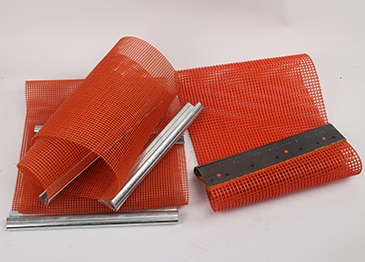Vibrating screens often encounter the problem of screen blockage when sieving materials. This article analyzes the possible causes of screen blockage, and solves the problem of blockage by corresponding methods.
The processing capacity of the vibrating screen is positively related to the effective opening rate of the screen. The larger the effective opening rate, the better the penetration of the material and the greater the processing capacity of the vibrating screen. In actual production applications, there are two factors that cause the effective opening rate of the vibrating screen to decrease (that is, the screen is blocked):
One is the proximity effect, which refers to the blockage formed by the particles having a similar aperture diameter embedded in the mesh;
There is also the accumulation effect, which is mostly caused by the stickiness of the materials or the blockage of the screen caused by accumulation and agglomeration due to electrostatic mutual adsorption. Therefore, to ensure the throughput, the cleanliness of the industrial screen mesh must be maintained.
There are generally two reasons for the blockage of the vibrating screen: the first material, and the second screen.
Specifically, the reasons for the blockage of the vibrating screen can be summarized as follows:
1. The density of the material is high, and the selection of the screen is inappropriate;
2. The material to be screened is wet;
3. The material to be screened has static electricity or is easy to stick;
4. The screened material is lighter;
5. The screen wire has a large diameter and is not easy to blank;
6. The bottom of the screen lacks a net cleaning device (rubber bouncing ball), also known as a clear tennis ball.
If the screen is blocked, the first thing to consider is whether the particle size of the screened material is appropriate, and more importantly, the characteristics of the screened material. If it is viscous, it will easily stick to the screen and cause the screening efficiency to drop. You can properly adjust the amplitude of the vibrating screen to see the effect.
In addition, the poor self-cleaning ability of the screen may also cause the mesh to be blocked. At this time, if the vibrating screen permits, a ball support plate can be installed, which uses the principle of a bouncing ball to clean the screen.
1. Analyze and judge the materials to be screened, and select the appropriate screen.
2. When sieving materials with fine particles, high water content, and more mud content, the materials are easy to bond, and when the moisture is greater than 5%, they need to be dried, dehydrated and then screened. If the moisture is greater than 8%, wet screening is required.
3. For materials with more flake particles, pay attention to adjusting the crushing method of the materials and the particle size matching of different crushing processes.
4. The vibrating screen mesh is equipped with different numbers of rubber elastic balls under different meshes.
5. Reasonable adjustment of the tension of the vibrating screen is an effective way to reduce the hole blocking of the screen. The reasonable tension makes the screen and the supporting beam produce slight secondary vibration, thereby effectively reducing the phenomenon of hole blocking. Occurrence, this can better make the screen work properly.
The specific method is: to make the tension hook into a constant tension mechanism, that is, install a spring on the tension bolt, so as to avoid the phenomenon of blocking the holes of the vibrating screen, and improve the screening effect, so that the vibrating screen can be screened with higher efficiency.

